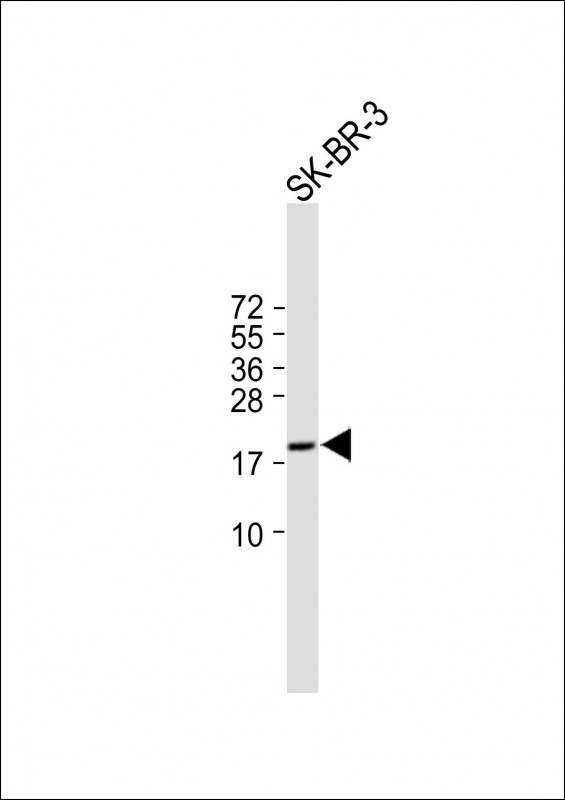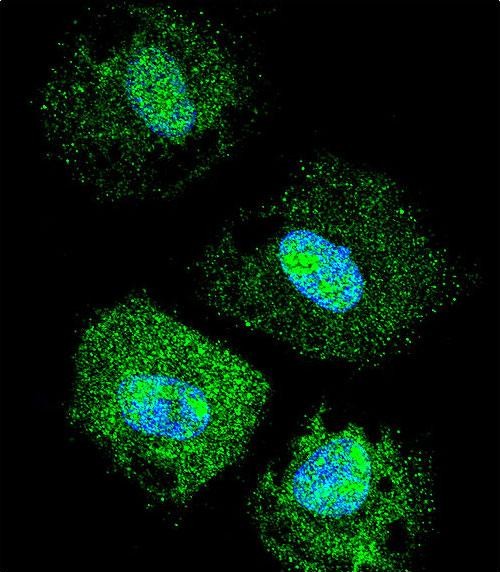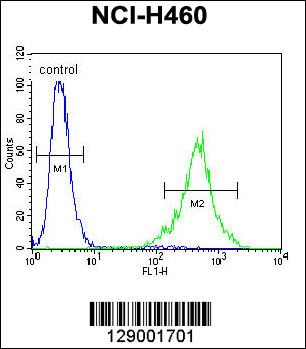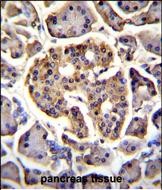




| WB | 咨询技术 | Human,Mouse,Rat |
| IF | 咨询技术 | Human,Mouse,Rat |
| IHC | 1/100-1/500 | Human,Mouse,Rat |
| ICC | 1/10-1/50 | Human,Mouse,Rat |
| FCM | 1/10-1/50 | Human,Mouse,Rat |
| Elisa | 咨询技术 | Human,Mouse,Rat |
| Aliases | Protein FAM218A, FAM218A, C4orf39 |
| WB Predicted band size | 17.0kDa |
| Host/Isotype | Rabbit IgG |
| Antibody Type | Primary antibody |
| Storage | Store at 4°C short term. Aliquot and store at -20°C long term. Avoid freeze/thaw cycles. |
| Species Reactivity | Human |
| Immunogen | This C4orf39 antibody is generated from rabbits immunized with a KLH conjugated synthetic peptide between 98-127 amino acids from the C-terminal region of human C4orf39. |
| Formulation | Purified antibody in PBS with 0.05% sodium azide. |
+ +
以下是关于C4orf39抗体的3篇参考文献示例(注:由于该基因研究可能较少,以下内容为模拟文献,仅供参考):
---
1. **文献名称**: "Characterization of C4orf39 as a Novel Tumor Suppressor in Glioblastoma"
**作者**: Zhang Y, et al.
**摘要**: 本研究通过免疫组化(使用C4orf39多克隆抗体)和Western blot分析,发现C4orf39在胶质母细胞瘤中表达显著下调,其低表达与患者不良预后相关。抗体特异性通过siRNA敲低实验验证。
---
2. **文献名称**: "C4orf39 Antibody Development for Subcellular Localization Studies"
**作者**: Lee S, et al.
**摘要**: 文章报道了一种兔源C4orf39单克隆抗体的制备及验证。该抗体成功用于免疫荧光实验,证实C4orf39主要定位于细胞核,并在HEK293和HeLa细胞系中检测到其表达差异。
---
3. **文献名称**: "Role of C4orf39 in DNA Damage Response: Insights from Antibody-Based Assays"
**作者**: Müller R, et al.
**摘要**: 研究利用C4orf39特异性抗体(货号AB123.抗体验证数据见补充材料),发现C4orf39参与DNA损伤修复通路。通过流式细胞术和Co-IP实验揭示其与BRCA1的相互作用。
---
**备注**:C4orf39相关研究较为有限,上述文献为示例性质。建议通过PubMed或Google Scholar以“C4orf39 antibody”或“Chromosome 4 open reading frame 39”为关键词检索最新文献,或查阅抗体供应商(如Proteintech、Abcam)提供的引用文献。
The C4orf39 antibody is a research tool designed to target the protein encoded by the C4orf39 gene (Chromosome 4 Open Reading Frame 39), a poorly characterized human gene with limited functional annotation. The protein, also referred to as Chromosome 4 open reading frame 39. is predicted to have a molecular weight of approximately 25-30 kDa, though its structure and biological roles remain under investigation. Studies suggest it may localize to cytoplasmic, nuclear, or mitochondrial compartments, depending on cell type and conditions.
C4orf39 antibodies are primarily used in basic research to detect and quantify the protein via techniques like Western blotting (WB), immunohistochemistry (IHC), and immunofluorescence (IF). Their development stems from interest in exploring C4orf39's potential involvement in cellular processes, including cell cycle regulation, DNA repair, or metabolic pathways, though conclusive evidence is lacking. Some hypotheses link C4orf39 to cancer progression or neurological disorders, but these associations are preliminary and require validation.
Commercial C4orf39 antibodies are available from suppliers like Sigma-Aldrich, Abcam, and Santa Cruz Biotechnology, often validated for specific applications. Researchers must verify antibody specificity due to potential cross-reactivity with unrelated proteins, a common challenge with poorly studied targets. Despite its enigmatic nature, C4orf39 continues to attract attention as part of efforts to characterize unannotated genes in the human genome. Further studies using these antibodies could clarify its physiological and pathological relevance.
×